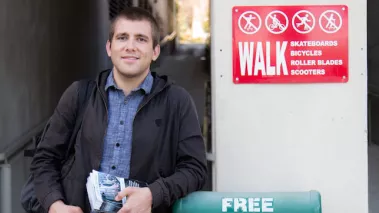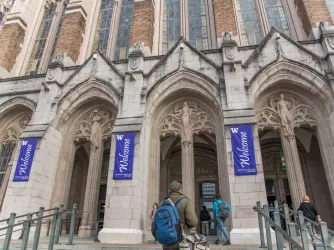Table of Contents
Two Reasons Why Cal Poly Pomona Lawsuit Is Different

Last week, student Nicolas Tomas sued California State Polytechnic University, Pomona for violating his First Amendment rights by limiting his efforts to campaign for animal rights to a tiny “free speech zone” that makes up about 0.01 percent of the campus. Tomas’s suit, the ninth in FIRE’s Stand Up For Speech Litigation Project (SUFS), was the fifth to challenge the constitutionality of a free speech zone—a particularly obvious type of violation of the First Amendment that FIRE has challenged both in and out of court for years. This case has produced two interesting variations, however.
First, students at Cal Poly Pomona have rallied (literally) to Tomas’s side. Yesterday, students from Young Americans for Liberty (YAL) organized a protest against the free speech zone to support the lawsuit. Although other SUFS plaintiffs have received support from their fellow students and faculty, this is the first time, as far as we know, that a student organization has stood up publicly to add additional voices to the demand to allow free expression on campus. The goal of Stand Up For Speech is to inspire systematic change throughout American higher education to welcome free expression and dialogue on campus, and we can’t do that without support from all students, not just our SUFS plaintiffs. And we need all the help we can get.
Cal Poly Pomona’s second “first” is an enormous facepalm. FIRE is used to university administrators coming up with lame excuses when they are caught violating the free speech rights of their students. It’s so common for administrators to say, “We were changing our policies anyway” when we force them to reform unconstitutional “red light” speech codes that we jokingly say it would make a great slogan on a FIRE T-shirt. The SUFS equivalent seems to be, “The student should have just reached out to us before suing and then none of this would have been necessary”—ignoring the fact that our student and faculty plaintiffs frequently come to us only after months, or even years, of trying on their own to get the schools to respect the First Amendment.
Cal Poly’s spokeswoman took this to a whole new level in responding to an article by Beau Yarbrough in the Daily Bulletin titled “Cal Poly Pomona student sues over ‘free speech zone.’” Tomas attempted numerous times to convince administrators that the Constitution guaranteed him freedom for his activism. He has a video showing a police officer shutting down his efforts to hand out literature because he didn’t have a “permit.” That same video shows Cal Poly’s former president, the man who promulgated the restrictive policies, confirming that Tomas needed permission from the Office of Student Life to speak. Nevertheless, the Daily Bulletin reported Cal Poly’s spokeswoman saying:
Campus officials misspoke about the campus free speech policy to Tomas, according to Cal Poly spokeswoman Esther Tanaka.
“The whole campus is a free speech zone, so long as it’s not within 50 feet of a class,” she said, “but (the spot between the library and student center) is where most of the people go, because that’s where the students are.”
[...]
“It might be, in this case, that (employees) were not clear on the presidential guidelines,” Tanaka said. “As long as you’re not preventing people from where they want to go and as long as you’re not disrupting classes, those are the two big (restrictions).”
That’s an awful lot of confused administrators, not to mention police officers. Maybe that’s because the 2014 presidential policy also says: “Non-commercial solicitation [i.e., leafleting] is prohibited unless prior written authorization has been obtained from the Campus President or designee” and directs people to the Office of Student Life to obtain the necessary permission. The policy further states:
Solicitations … are permitted subject to the following time, place, and manner regulations.
TIME: Monday through Friday, 8 a.m. to 10 p.m.
PLACE: (1) In the University Park, northeast grassy area of the entrance to the Bronco Student Center, and (2) in areas so designated by the Office of Student Life and Cultural Centers.
How even the most broad-minded campus administrator could interpret that language to mean “the entire campus is a free speech zone” will not remain a mystery for long. Thanks to Tomas’s lawsuit, Cal Poly Pomona administrators will have ample opportunity in the coming months to explain to a federal judge how to connect those dots. FIRE will, of course, share any and all explanations as we learn of them.
Recent Articles
FIRE’s award-winning Newsdesk covers the free speech news you need to stay informed.

FIRE’s defense of pollster J. Ann Selzer against Donald Trump’s lawsuit is First Amendment 101

University of Washington alumni seek to revive the spirit of free inquiry

Meta’s content moderation changes closely align with FIRE recommendations
